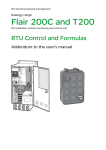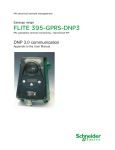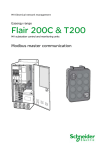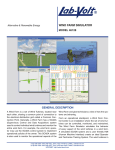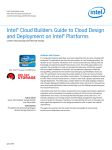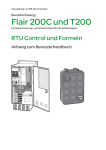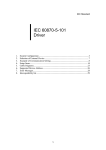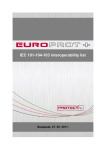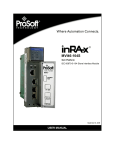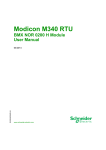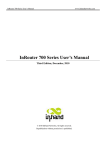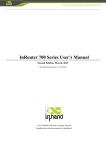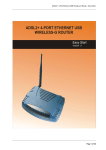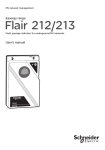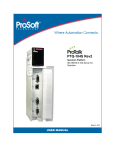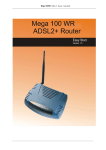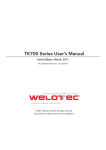Download "MV substation control and monitoring units"
Transcript
MV electrical network management Easergy range T200 & Flair 200C & R200-ATS100 MV substation control and monitoring units IEC 870-5-104 communication Appendix to the User Manual T200, Flair 200C, R200 Contents 1. ABOUT THE BOOK ..................................................................................................................................... 3 2. IEC 60 870-5-104 ......................................................................................................................................... 4 2.1. PRESENTATION .............................................................................................................................................. 4 2.2. INTEROPERABILITY TABLE .............................................................................................................................. 5 2.3. PROTOCOL CHARACTERISTICS .....................................................................................................................17 Transmission pile size ...................................................................................................................................17 Possible data-flow .........................................................................................................................................17 Configuration .................................................................................................................................................17 R200-ATS100 Configuration .........................................................................................................................19 2.4. BIBLIOGRAPHY .............................................................................................................................................20 3. OBJECT ADDRESSING ............................................................................................................................21 2 NT00199-EN-08 T200, Flair 200C, R200 About the book 1. About the book Presentation Document scope This manual describes the IEC 870-5-104 protocol implementation on T200 and Flair 200C products Application field Apply to T200 and Flair 200C products Document’s evolutions V1.0: Creation of IEC 870-5-104 user’s manual. V1.1: Flair 200C added V1.2: T200 V3.3 release : • Redundancy until 8 connections • Dating validity through SNTP V1.3 : Interoperability table update, add of Set point Commands Related documents User comments NT00199-EN-08 3 T200, Flair 200C, R200 IEC 60 870-5-104 2. IEC 60 870-5-104 2.1. Presentation Definition The IEC 60870-5-104 protocol is derived from the IEC 60870-5-101 protocol. This one was specified on a serial link whereas IEC 60870-5-104 is an application running on a TCP/IP layer Main differences between the 2 protocols are : • management of the TCP/IP layer interface (APCI) • new functions (ASDU) that have been added. IEC 60870-5-101 protocol specifies frame format and the IEC 60870-5-104 protocol specifies the frame format of the transport interface (APCI) as well as exchanging rules between two equipments. Thus the equipment can communicate with a supervisor (or another equipment). ISO Model Transmission mode Data Features Interoperability The IEC 60870-5-104 protocol is based on TCP/IP transport profile. It is located exclusively on layer 7 of the ISO model but can be considered as made of two sub-layers : • Transport interface : APCI (Application Protocol control Information) • ASDU from IEC 60870-5-101 and IEC 60870-5-104 selection The protocol is client – server application. The equipment is acting as a server, and the supervisor (SCADA) is acting as the client and connect the server. The IEC 870-5-104 protocol specifies the data that can be exchanged and the format used for transmission. Among the different data types provided by the protocol, we can quote: • signalisations (singles or doubles), • measured values (with different formats), • integrated totals, • commands, • parameters. Features are associated to particular data types. For example : • general interrogation, • clock synchronisation, • events transmission (time-stamped or not), • integrated totals specific treatment (freezing, reset,…) • command transmission modes (select and execute mode or direct mode) • parameters activation. Depending on their specifications, connected equipments do not use the same data types or features define by the protocol In order to evaluate the compatibility between different equipments that should be connected, each manufacturer provides a document, called Interoperability table, where the used data and features are shown and detailed. 4 NT00199-EN-08 T200, Flair 200C, R200 IEC 60 870-5-104 2.2. Interoperability Table REMARKS This companion standard presents sets of parameters and alternatives from which subsets must be selected to implement particular telecontrol systems. Certain parameter values, such as the choice of “structured“ or “unstructured“ fields of the INFORMATION OBJECT ADDRESS of ASDUs represent mutually exclusive alternatives. This means that only one value of the defined parameters is admitted per system. Other parameters, such as the listed set of different process information in command and in monitor direction allow the specification of the complete set or subsets, as appropriate for given applications. This clause summarizes the parameters of the previous clauses to facilitate a suitable selection for a specific application. If a system is composed of equipment stemming from different manufacturers, it is necessary that all partners agree on the selected parameters. The interoperability list is defined as in IEC 60870-5-101 and extended with parameters used in this standard. The text descriptions of parameters which are not applicable to this companion standard are strikethrough (corresponding check box is marked black). System or device system-specific parameter, indicate the station’s function by marking one of the following with ‘X’ System definition Controlling station definition (MASTER) X Controlled station definition (SLAVE) Network Configuration network-specific parameter, all configurations that are used are to be marked ‘X’ Point-to-point Multipoint-party line Multiple point-to-point Multipoint-star Physical layer Transmission speed Unbalanced interchange Circuit V.24/V.28 Standard network-specific parameter, all interfaces and data rates that are used are to be marked ‘X’ Control direction Unbalanced interchange Circuit V.24/V.28 Recommended if >1200bit/s Balanced interchange Circuit X.24/X.27 100 bit/s 2 400 bit/s 2 400 bit/s 56 000 bit/s 200 bit/s 4 800 bit/s 4 800 bit/s 64 000 bit/s 300 bit/s 9 600 bit/s 9 600 bit/s 600 bit/s 19 200 bit/s 1 200 bit/s 38 400 bit/s Transmission speed NT00199-EN-08 Monitor direction 5 T200, Flair 200C, R200 Unbalanced interchange Circuit V.24/V.28 Standard IEC 60 870-5-104 Unbalanced interchange Circuit V.24/V.28 Recommended if >1 200bit/s Balanced interchange Circuit X.24/X.27 100 bit/s 2 400 bit/s 2 400 bit/s 56 000 bit/s 200 bit/s 4 800 bit/s 4 800 bit/s 64 000 bit/s 300 bit/s 9 600 bit/s 9 600 bit/s 600 bit/s 19 200 bit/s 1 200 bit/s 38 400 bit/s LINK LAYER network-specific parameter, all options that are used are to be marked ‘X’. Specify the maximum frame length. If a non-standard assignment of class 2 messages is implemented for unbalanced transmission, indicate the Type ID and COT of all messages assigned to class 2. Frame format FT 1.2, single character 1 and the fixed time out interval are used exclusively in this companion standard. Link transmission procedure Address field of the link Balanced transmission Not present (balanced transmission only) Unbalanced transmission One octet Frame length Two octets maximum length L (number of octets) Structured Unstructured When using an unbalanced link layer, the following ASDU types are returned in class 2 messages (low priority) with the indicated causes of transmission: The standard assignment of ASDUs to class 2 messages is used as follows: Type identification Cause of transmission 9, 11, 13, 21 <1> A special assignment of ASDUs to class 2 messages is used as follows: Type identification Cause of transmission NOTE : In response to a class 2 poll, a controlled station may respond with class 1 data when there is no class 2 data available 6 NT00199-EN-08 T200, Flair 200C, R200 IEC 60 870-5-104 Application layer TRANSMISSION MODE FOR APPLICATION D ATA : Mode 1 (Least significant octet first), as defined in clause 4.10 of IEC 60870-5-4, is used exclusively in this companion standard.. Common Address of ASDU system-specific parameter, all configurations that are used are to be marked ‘X’ X One octet Information object address system-specific parameter, all configurations that are used are to be marked ‘X’ One octet Structured X Two octets X Two octets Unstructured Three octets Cause of transmission system-specific parameter, all configurations that are used are to be marked ‘X’ X One octet Two octets (with originator address) originator address is set to zero Length of APDU system-specific parameter, specify the maximum length of the APDU per system The maximum length of the APDU is 253 (default). The maximum length may be reduced by the system. 253 Maximum length of APDU per system Selection of standard ASDUs station-specific parameter, mark each Type ID ‘X’ if it is only used in the standard direction, ‘R’ if only used in the reverse direction, and ‘B’ if used in both directions PROCESS INFORMATION IN MONITOR DIRECTION X <1> <2> X <3> <4> <5> NT00199-EN-08 : = : = : = : = : = Single-point information M_SP_NA_1 Single-point information with time tag M_SP_TA_1 Double-point information M_DP_NA_1 Double-point information with time tag M_DP_TA_1 Step position information M_ST_NA_1 7 T200, Flair 200C, R200 <6> <7> <8> X <9> <10> X <11> <12> X <13> <14> X <15> <16> <17> <18> <19> <20> <21> X <30> X <31> <32> <33> X <34> X <35> X <36> X <37> <38> <39> <40> : = : = : = : = : = : = : = : = : = : = : = : = : = : = : = : = : = : = : = : = : = : = : = : = : = : = IEC 60 870-5-104 Step position information with time tag M_ST_TA_1 Bit string of 32 bit M_BO_NA_1 Bit string of 32 bit with time tag M_BO_TA_1 Measured value, normalized value M_ME_NA_1 Measured value, normalized value with time tag M_ME_TA_1 Measured value, scaled value M_ME_NB_1 Measured value, scaled value with time tag M_ME_TB_1 Measured value, short floating point value M_ME_NC_1 Measured value, short floating point value with time tag M_ME_TC_1 Integrated totals M_IT_NA_1 Integrated totals with time tag M_IT_TA_1 Event of protection equipment with time tag M_EP_TA_1 Packed start events of protection equipment with time tag M_EP_TB_1 Packed output circuit information of protection equipment with time tag M_EP_TC_1 Packed single-point information with status change detection M_PS_NA_1 Measured value, normalized value without quality descriptor M_ME_ND_1 Single-point information with time tag CP56Time2a M_SP_TB_1 Double-point information with time tag CP56Time2a M_DP_TB_1 Step position information with time tag CP56Time2a M_ST_TB_1 Bit string of 32 bit with time tag CP56Time2a M_BO_TB_1 Measured value, normalized value with time tag CP56Time2a M_ME_TD_1 Measured value, scaled value with time tag CP56Time2a M_ME_TE_1 Measured value, short floating point value with time tag CP56Time2a M_ME_TF_1 Integrated totals with time tag CP56Time2a M_IT_TB_1 Event of protection equipment with time tag CP56Time2a M_EP_TD_1 Packed start events of protection equipment with time tag CP56Time2a M_EP_TE_1 : Packed output circuit information of protection equipment with time tag CP56Time2a = M_EP_TF_1 Either the ASDUs of the set <2>, <4>, <6>, <8>, <10>, <12>, <14> >, <16>, <17>, <18>, <19> or of the set <30> – <40> are used station-specific parameter, mark each Type ID ‘X’ if it is only used in the standard direction, ‘R’ if only used in the reverse direction, and ‘B’ if used in both directions Process information in control direction X <45> X <46> <47> X <48> X <49> 8 : = : = : = : = : = Single command C_SC_NA_1 Double command C_DC_NA_1 Regulating step command C_RC_NA_1 Set point command, normalized value C_SE_NA_1 Set point command, scaled value C_SE_NB_1 NT00199-EN-08 T200, Flair 200C, R200 X : = : = : = : = : = : = : = : = : = <50> <51> X <58> X <59> <60> X <61> X <62> X <63> <64> IEC 60 870-5-104 Set point command, short floating point value C_SE_NC_1 Bit string of 32 bit C_BO_NA_1 Single command with time tag CP56Time 2a C_SC_TA_1 Double command with time tag CP56Time 2a C_DC_TA_1 Regulating step command with time tag CP56Time 2a C_RC_TA_1 Set point command, normalized value with time tag CP56Time 2a C_SE_TA_1 Set point command, scaled value with time tag CP56Time 2a C_SE_TB_1 Set point command, short floating point value with time tag CP56Time 2a C_SE_TC_1 Bit string of 32 bit with time tag CP56Time 2a C_BO_TA_1 Either the ASDUs of the set <45> – <51>or of the set <58>-<64> are used. System information in monitor direction X <70> station-specific parameter, mark ‘X’ if used := End of initialization System information in control direction M_EI_NA_1 station-specific parameter, mark ‘X’ if used X <100> := Interrogation command C_IC_NA_1 X <101> := Counter interrogation command C_CI_NA_1 X <102> := Read command C_RD_NA_1 X <103> := Clock synchronization command C_CS_NA_1 <104> : Test command = C_TS_NA_1 <105> := Reset process command C_RP_NA_1 <106> := Delay acquisition command C CD NA 1 <107> := Test command with time tag CP56time2a C_TS_TA_1 X Parameter in control direction station-specific parameter, mark ‘X’ if used <110> := Parameter of measured value, normalized value P_ME_NA_1 <111> := Parameter of measured value, scaled value P_ME_NB_1 <112> := Parameter of measured value, short floating point value P_ME_NC_1 <113> := Parameter activation P_AC_NA_1 NT00199-EN-08 9 IEC 60 870-5-104 T200, Flair 200C, R200 File Transfer station-specific parameter, mark each Type ID ‘X’ if it is only used in the standard direction, ‘R’ if only used in the reverse direction, and ‘B’ if used in both directions <120> := File ready F_FR_NA_1 <121> := Section ready F_SR_NA_1 <122> := Call directory, select file, call file, call section F_SC_NA_1 <123> := Last section, last segment F_LS_NA_1 <124> := Ack file, ack section F_AF_NA_1 <125> := Segment F_SG_NA_1 <126> := Directory (blank or X, only available in monitor (standard) direction) F_DR_TA_1 Type identifier and causes of transmission assignment station-specific parameters Shaded boxes are not required. Black boxes are not permitted in this companion standard Blank: functions or ASDU not used. Mark Type Identification/Cause of transmission combinations: ‘X’ if only used in the standard direction ‘R’ if only used in the reverse direction ‘B’ if used in both directions Type Identification Cause of transmission 1 <1> <2> <3> <4> <5> <6> <7> <8> <9> <10> <11> <12> <13> <14> <15> <16> <17> <18> <19> <20> <21> <30> <31> <32> <33> 10 M_SP_NA_1 M_SP_TA_1 M_DP_NA_1 M_DP_TA_1 M_ST_NA_1 M_ST_TA_1 M_BO_NA_1 M_BO_TA_1 M_ME_NA_1 M_ME_TA_1 M_ME_NB_1 M_ME_TB_1 M_ME_NC_1 M_ME_TC_1 M_IT_NA_1 M_IT_TA_1 M_EP_TA_1 M_EP_TB_1 M_EP_TC_1 M_PS_NA_1 M_ME_ND_1 M_SP_TB_1 M_DP_TB_1 M_ST_TB_1 M_BO_TB_1 2 3 4 5 X X 20 à 36 X X X X X X X X X X X X X X X X X X X 6 7 8 9 10 11 12 13 37 à 41 44 45 46 47 X X X NT00199-EN-08 T200, Flair 200C, R200 <34> M_ME_TD_1 <35> M_ME_TE_1 <36> M_ME_TF_1 <37> M_IT_TB_1 <38> M_EP_TD_1 <39> M_EP_TE_1 <40> M_EP_TF_1 <45> C_SC_NA_1 <46> C_DC_NA_1 <47> C_RC_NA_1 <48> C_SE_NA_1 <49> C_SE_NB_1 <50> C_SE_NC_1 <51> C_BO_NA_1 <58> C_SC_TA_1 <59> C_DC_TA_1 <60> C_RC_TA_1 <61> C_SE_TA_1 <62> C_SE_TB_1 <63> C_SE_TC_1 <64> C_BO_TA_1 <70> M_EI_NA_1 <100 C_IC_NA_1 > <101 C_CI_NA_1 > <102 C_RD_NA_1 > <103 C_CS_NA_1 > <104 C_TS_NA_1 > <105 C_RP_NA_1 > C_CD_NA_1 <106 > <107 C_TS_TA_1 > <110 P_ME_NA_1 > <111 P_ME_NB_1 > <112 P_ME_NC_1 > <113 P_AC_NA_1 > <120 F_FR_NA_1 > <121 F_SR_NA_1 > <122 F_SC_NA_1 > <123 F_LS_NA_1 > <124 F_AF_NA_1 > <125 F_SG_NA_1 > a) <126 F_DR_TA_1 > a) Blank or X only NT00199-EN-08 X X X X IEC 60 870-5-104 X X X X X X X X X X X X X X X X X X X X X X X X X X X X X X X X X X X X X X X X X X X X X X X X X X X X X X X X X X X X X X X X X X X X 11 T200, Flair 200C, R200 IEC 60 870-5-104 Basic application functions Station initialization X station-specific parameter, mark ‘X’ if function is used Remote initialization Cyclic data transmission X station-specific parameter, mark ‘X’ if function is only used in the standard direction, ‘R’ if only used in the reverse direction, and ‘B’ if used in both directions Cyclic data transmission Read procedure X station-specific parameter, mark ‘X’ if function is only used in the standard direction, ‘R’ if only used in the reverse direction, and ‘B’ if used in both directions Read Procedure station-specific parameter, mark ‘X’ if function is used Spontaneous transmission X Spontaneous transmission Double station-specific parameter, mark each information type ‘X’ where both a Type ID without time transmission of and corresponding Type ID with time are issued in response to a single spontaneous change information of a monitored object. objects with cause of transmission spontaneous The following type identifications may be transmitted in succession caused by a single status change of an information object. The particular information object addresses for which double transmission is enabled are defined in a projectspecific list Single-point Information M_SP_NA_1, M_SP_TA_1, M_SP_TB_1 and M_PS_NA_1 Diouble-point Information M_DP_NA_1, M_DP_TA_1 and M_DP_TB_1 Step position information M_ST_NA_1, M_ST_TA_1 and M_ST_TB_1 Bitstring of 32 bit M_BO_NA_1, M_BO_TA_1 and M_BO_TB_1 (if defined for a specific project) Measured value, normalized value M ME NA 1, M ME TA 1, M ME ND 1 and M ME TD 1 Measured value, scaled value M ME NB 1, M ME TB 1 and M ME TE 1 Measured value, short floating point number M_ME_NC_1, M_ME_TC_1 and M_ME_TF_1 12 NT00199-EN-08 T200, Flair 200C, R200 IEC 60 870-5-104 Station Interrogation station-specific parameter, mark ‘X’ if function is only used in the standard direction, ‘R’ if only used in the reverse direction, and ‘B’ if used in both directions Clock synchronization station-specific parameter, mark ‘X’ if function is only used in the standard direction, ‘R’ if only used in the reverse direction, and ‘B’ if used in both directions. X X global group 1 group 7 group 13 group 2 group 8 group 14 group 3 group 9 group 15 group 4 group 10 group 16 group 5 group 11 group 6 group 12 Clock synchronization Command transmission X Information Object Addresses assigned to each group must be shown in a separate table station-specific parameter, mark ‘X’ if function is only used in the standard direction, ‘R’ if only used in the reverse direction, and ‘B’ if used in both directions. Direct command transmission Direct set point command transmission X Select and execute command Select and execute set point command C_SE ACTTERM used NT00199-EN-08 13 T200, Flair 200C, R200 Transmission of integrated totals X IEC 60 870-5-104 station-specific parameter, mark ‘X’ if function is only used in the standard direction, ‘R’ if only used in the reverse direction, and ‘B’ if used in both directions Mode A: Local freeze with spontaneous transmission Mode B: Local freeze with counter interrogation Mode C: Freeze and transmit by counter-interrogation commands Mode D: Freeze by counter-interrogation command, frozen values reported spontaneously Counter read Counter freeze without reset Counter freeze with reset Counter reset X General request counter Request counter group 1 Request counter group 2 Request counter group 3 Request counter group 4 Parameter loading station-specific parameter, mark ‘X’ if function is only used in the standard direction, ‘R’ if only used in the reverse direction, and ‘B’ if used in both directions Threshold value Smoothing factor Low limit for transmission of measured values High limit for transmission of measured values Parameter activation station-specific parameter, mark ‘X’ if function is only used in the standard direction, ‘R’ if only used in the reverse direction, and ‘B’ if used in both directions Act/deact of persistent cyclic or periodic transmission of the addressed object Test procedure station-specific parameter, mark ‘X’ if function is only used in the standard direction, ‘R’ if only used in the reverse direction, and ‘B’ if used in both directions Test Procedure File transfer 14 station-specific parameter, mark ‘X’ if function is used NT00199-EN-08 T200, Flair 200C, R200 IEC 60 870-5-104 File transfer in monitor direction Transparent file Transmission of disturbance data of protection equipment Transmission of sequences of events Transmission of sequences of recorded analog values File transfer in control direction Transparent file Background scan station-specific parameter, mark ‘X’ if function is only used in the standard direction, ‘R’ if only used in the reverse direction, and ‘B’ if used in both directions Background scan Acquisition of transmission delay Acquisition of transmission delay Definition of timeouts Parameter t0 t1 Default value 30 s 15 s t2 10 s t3 20 s Remarks Time-out of connection establishment Maximum time to wait until the Supervisor indicates that it has correctly received the frame previously send by the unit. If the confirmation is not received, the session is closed. Maximum time to wait before to send a S frame confirmation for frames received from the Supervisor. (T2 < T1) If no data transfers occur during a certain period of time, a frame will be send to test the link. (T3>T1) Selected value 30 s Configurable Configurable Configurable Maximum range of values k: 1 to 32767 (215-1) APDUs, accuracy 1 APDU Maximum range of values w: 1 to 32767 APDUs, accuracy 1 APDU (Recommendation: w should not exceed two-thirds of k). Because of memory limitations, k and w are limited to 20 APDUs with w < k NT00199-EN-08 15 T200, Flair 200C, R200 IEC 60 870-5-104 Port Number Parameter Port number 8 Remark configurable Number N of redundancy group connections used. (T200 only) RFC 2200 suite 16 Value 2404 RFC 2200 is an official Internet Standard which describes the state of standardization of protocols used in the Internet as determined by the Internet Architecture Board (IAB). It offers a broad spectrum of actual standards used in the Internet. The suitable selection of documents from RFC 2200 defined in this standard for given projects has to be chosen by the user of this standard. NT00199-EN-08 T200, Flair 200C, R200 2.3. IEC 60 870-5-104 Protocol Characteristics Transmission pile size Transmission pile is linked to the number of events that can be kept in memory as long as the SCADA has not read them. This is important when communication is lost or when the events flow is bigger than the protocol data-flow. In all cases, those events are lost in case of equipment shut down. The equipment deals with digitals information (TOR), integrated totals or measured values. The size of the transmission pile is 350 events for each type Possible data-flow With a point to point connection on an 10/100Mb/s Ethernet link, the protocol is able to transmit 1000 events per seconds. WARNING : Performances are dependent on the Ethernet network. Configuration NT00199-EN-08 The list of available parameters is the following : 17 T200, Flair 200C, R200 IEC 60 870-5-104 Protocol 60 870-5-104 Configuration page Paragraph Parameter Configuration limits 0.0.0.0 to SCADAs IP_client1 à 255.255.255.255 Adresses IP_client8 (T200 only) General protocol parameters Interoperability (Transmission) Interoperability (Application) Comments 255.255.255.25 5 The product allowed until 8 redundancy connections. Incoming addresses can be filtered 0.0.0.0 means that no incoming connections are allowed. 255.255.255.255 means that all incoming connections are allowed. Common ASDU Address 1 to 65534 1 The equipment has a unique database for the all variables (only one ASDU address) TCP/IP Port 1 to 65534 2404 Frame Length (max) K 4 to 253 253 1 to 20 12 W 1 to 20 8 T1 1 to 255 60 s T2 1 to 255 20 s T3 1 to 255 120 s Measured value Adjusted or Normalized or Floating Yes or No Adjusted IEC 870-5-104 standard specifies that the number must be 2404. It is here configurable to be able to use any TCP/IP network. Maximum length of APDU (Application Protocol Data Unit) Number of frame that the unit can send without receiving acknowledged from the Supervisor. Number of frames that the unit can receive without sending acknowledgement. (W < 2/3K) Maximum time to wait until the Supervisor indicates that it has correctly received the frame previously send by the unit. If the confirmation is not received, the session is closed. Maximum time to wait before to send a S frame confirmation for frames received from the Supervisor. (T2 < T1) If no data transfers occur during a certain period of time, a frame will be send to test the link. (T3>T1) Define measured value format to the SCADA Use SNTP clock validity Yes or No No Clock validity 0 to 86400 s 3600 s Command type Direct or Selection and execution 1 to 60 s Direct Select Timeout 0 to 60 s 5s Single-point dating Double-point dating Yes or No Yes Yes or No Yes End of init Transmission Command timeout 18 Default Configuration Yes 5s Send or not a frame type M_EI_NA_1 once the communication is established with the SCADA For signalization with time tag, the validity / invalidity of the dating can be given by SNTP synchronization by checking the option. Activation delay of the « clock validity » bit in CP56Time2a format after a synchronization made by the protocol 60870-5-104. 0 correspond to an ‘always valid’ clock. Command by the protocol mode In case of command with time (C_SC_TA_1 or C_DC_TA_1), define the validity delay of the command compare to the frame date and time In Selection and execution mode, define the maximum delay between the selection frame and the execution frame 0 correspond to an infinite delay Specify if spontaneous single-points events must be time-stamped or not. Specify if spontaneous double-points events must be time-stamped or not. NT00199-EN-08 T200, Flair 200C, R200 IEC 60 870-5-104 Integrated totals dating Measured value dating Yes or No Yes Yes or No Yes Cyclic Measured value dating Yes or No Yes Specify if spontaneous integrated totals events must be time-stamped or not. Specify if spontaneous measured value events (threshold, dead band) must be timestamped or not. Specify if cyclic measured value events must be time-stamped or not. R200-ATS100 Configuration The protocol configuration can be found under Settings \ SCADA communication \ Protocol. The parameters are similar to T200/F200C, and described in previous paragraph. • TCP port configuration: The TCP server port can be modified under Settings \ SCADA communication \ Ethernet Port NT00199-EN-08 19 T200, Flair 200C, R200 IEC 60 870-5-104 2.4. Bibliography IEC101 Standard The international standard has been specified by the International Electro technical Commission mainly in following documents: • • • • • • • IEC 60870-5-1: 1990, Telecontrol equipment and systems – Part 5: Transmission protocols – Section 1: Transmission frame formats IEC 60870-5-2: 1992, Telecontrol equipment and systems – Part 5: Transmission protocols – Section 2: Link transmission procedures IEC 60870-5-3: 1992, Telecontrol equipment and systems – Part 5: Transmission protocols – Section 3: General structure of application data IEC 60870-5-4: 1993, Telecontrol equipment and systems – Part 5: Transmission protocols – Section 4: Definition and coding of application information element IEC 60870-5-5: 1993, Telecontrol equipment and systems – Part 5: Transmission protocols – Section 5: Basic application functions IEC 60870-5-101: 2003, Telecontrol equipment and systems – Part 5-101: Transmission protocols – Companion standard for basic telecontrol tasks IEC 60870-5-104: 2000, Telecontrol equipment and systems – Part 5-104: Transmission protocols – Network access for IEC 60870-5-101 using standard transport profiles Previous documents use references to others useful documents with the following references : • • • • • • • • • 20 IEC 60050(371): 1984, International Electro technical Vocabulary (IEV) – Chapter 371: Telecontrol IEC 60870-1-1: 1988, Telecontrol equipment and systems – Part 1: General considerations – Section 1: General principles IEC 60870-5-103: 1997, Telecontrol equipment and systems – Part 5-103: Transmission protocols – Companion standard for the informative interface of protection equipment OSI/IEC 8824-1: 2000, Information technology – Abstract Syntax Notation One (ASN.1): Specification of basic notation ITU-T V.24: 2000, List of definitions for interchange circuits between data terminal equipment (DTE) and data circuit-terminating equipment (DCE) ITU-T V.28: 1993, Electrical characteristics for unbalanced double-current interchange circuits ITU-T X.24: 1988, List of definitions for interchange circuits between Data Terminal Equipment (DTE) and Data Circuit-terminating Equipment (DCE) on public data networks ITU-T X.27: 1996, Electrical characteristics for balanced double-current interchange circuits operating at data signalling rates up to 10 Mbit/s IEEE 754: 1985, Binary floating-point arithmetic NT00199-EN-08 T200, Flair 200C, R200 IEC 60 870-5-104 3. Object addressing The table of information object addresses for IEC 870-5-104 protocol is exactly the same as the one of the IEC 870-5-101 protocol. For the full list of these table addresses, consult the IEC 870-5-101 protocol user's manual (ref. NT00156-ENxx). NT00199-EN-08 21 T200 & Flair 200C 22 Personal notes NT00199-EN-08 T200 & Flair 200C NT00199-EN-08 Personal notes 23 Schneider Electric Industries SAS As standards, specifications and designs change from time to time, please ask for confirmation of the information given in this publication. Schneider Electric Telecontrol 839 chemin des Batterses Z.I. Ouest 01700 St Maurice de Beynost Tel : +33 (0)4 78 55 13 13 Fax : +33 (0)4 78 55 50 00 http://www.schneider-electric.com E-mail : [email protected] NT00199-EN-08 01/2014 Publication, production and printing : Schneider Electric Telecontrol Made in France - Europe
























